
Elizabeth Cavendish, later Elizabeth Talbot, Countess of Shrewsbury, known as Bess of Hardwick, of Hardwick Hall, Derbyshire, was a notable figure of Elizabethan English society. By a series of well-made marriages, she rose to the highest levels of English nobility and became enormously wealthy. Bess was reportedly a shrewd businesswoman, increasing her assets with business interests including mines and glass-making workshops.

Chatsworth House is a stately home in the Derbyshire Dales, 4 miles (6.4 km) north-east of Bakewell and 9 miles (14 km) west of Chesterfield, England. The seat of the Duke of Devonshire, it has belonged to the Cavendish family since 1549. It stands on the east bank of the River Derwent, across from hills between the Derwent and Wye valleys, amid parkland backed by wooded hills that rise to heather moorland. The house holds major collections of paintings, furniture, Old Master drawings, neoclassical sculptures and books. Chosen several times as Britain's favourite country house, it is a Grade I listed property from the 17th century, altered in the 18th and 19th centuries. In 2011–2012 it underwent a £14-million restoration. The owner is the Chatsworth House Trust, an independent charitable foundation formed in 1981, on behalf of the Cavendish family.
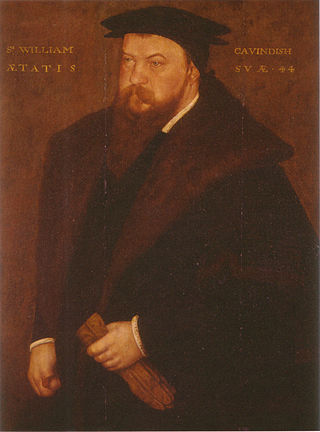
Sir William Cavendish MP was an English politician, knight and courtier. Cavendish held public office and accumulated a considerable fortune, and became one of Thomas Cromwell's "visitors of the monasteries" during the dissolution of the monasteries. He was MP for Thirsk in 1547. In 1547 he married Bess of Hardwick, and the couple began the construction of Chatsworth House in 1552, a project which would not be completed until after his death. His second son William Cavendish (1552–1626) became the first Earl of Devonshire, purchasing his title from the impecunious King James I.

Duke of Devonshire is a title in the Peerage of England held by members of the Cavendish family. This branch of the Cavendish family has been one of the wealthiest British aristocratic families since the 16th century and has been rivalled in political influence perhaps only by the Marquesses of Salisbury and the Earls of Derby.
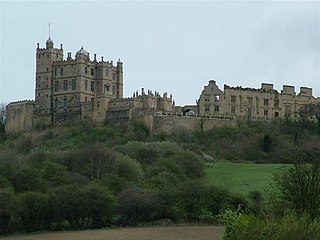
Bolsover Castle is in the town of Bolsover, in the north-east of the English county of Derbyshire. Built in the early 17th century, the present castle lies on the earthworks and ruins of the 12th-century medieval castle; the first structure of the present castle was built between 1612 and 1617 by Sir Charles Cavendish. The site is now in the care of the English Heritage charity, as both a Grade I listed building and a Scheduled Ancient Monument.

William Cavendish, 1st Duke of Devonshire, was an English Army officer, Whig politician and peer who sat in the House of Commons from 1661 until 1684 when he inherited his father's peerage as Earl of Devonshire and took his seat in the House of Lords. Cavendish was part of the "Immortal Seven" which invited William of Orange to depose James II of England as part of the Glorious Revolution, and was rewarded for his efforts by being elevated to the Duke of Devonshire in 1694.
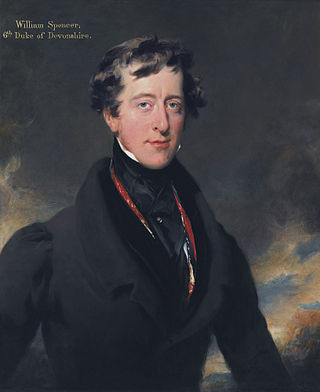
William George Spencer Cavendish, 6th Duke of Devonshire,, styled Marquess of Hartington until 1811, was a British peer, courtier, nobleman and Whig politician. Known as the "Bachelor Duke", he was Lord Chamberlain of the Household between 1827 and 1828 and again between 1830 and 1834. The Cavendish banana is named after him.
Peregrine Andrew Morny Cavendish, 12th Duke of Devonshire,, is an English peer. He is the only surviving son of Andrew Cavendish, 11th Duke of Devonshire, and his wife, the former Deborah Mitford. He succeeded to the dukedom following the death of his father on 3 May 2004. Before his succession, he was styled Earl of Burlington from 1944 until 1950 and Marquess of Hartington between 1950 and 2004. His immediate family are owner-occupiers of Chatsworth House and are worth an estimated £905 million. Estates landscaped before 1900 by the family are parts of Derbyshire and North Yorkshire. Other capital managed by the Duke includes fine and contemporary art, forestry and farming.

George Talbot, 6th Earl of Shrewsbury, 6th Earl of Waterford, 12th Baron Talbot, KG, Earl Marshal (c. 1522/1528 – 18 November 1590) was an English magnate and military commander. He also held the subsidiary titles of 15th Baron Strange of Blackmere and 11th Baron Furnivall. He was best known for his tenure as keeper of Mary, Queen of Scots between 1568 and 1585, his marriage to his second wife Elizabeth Talbot, as well as his surviving collection of written work.

William Cavendish, 1st Earl of Devonshire was an English nobleman, politician, and courtier.

William Cavendish, 2nd Earl of Devonshire was an English nobleman, courtier, and politician who sat in the House of Commons from 1614 until 1626 when he succeeded to the peerage and sat in the House of Lords.
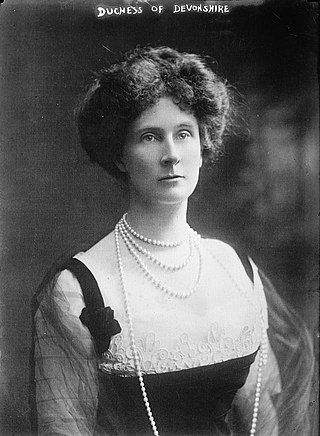
Evelyn Emily Mary Cavendish, Duchess of Devonshire,, was the wife of Victor Cavendish, 9th Duke of Devonshire. She was the elder daughter of politician and diplomat Henry Petty-Fitzmaurice, 5th Marquess of Lansdowne, and grew up amidst public life. Evelyn's marriage to Cavendish, nephew and heir presumptive of Spencer Cavendish, 8th Duke of Devonshire, led to her becoming Duchess of Devonshire in 1908. With her position, she oversaw the reorganisation of the Devonshire estates and presided over four English houses and one Irish castle.

Edensor is a village and civil parish in Derbyshire, England. The population of the civil parish at the 2011 census was 145.

Devonshire House in Piccadilly, was the London townhouse of the Dukes of Devonshire during the 18th and 19th centuries. Following a fire in 1733 it was rebuilt by William Cavendish, 3rd Duke of Devonshire, in the Palladian style, to designs by William Kent. Completed circa 1740, it stood empty after the First World War and was demolished in 1924.
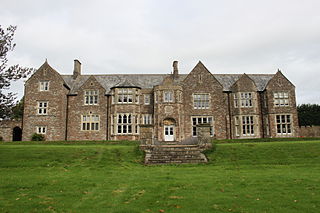
Sutton Court is an English house remodelled by Thomas Henry Wyatt in the 1850s from a manor house built in the 15th and 16th centuries around a 14th-century fortified pele tower and surrounding buildings. The house has been designated as Grade II* listed building.

Chatsworth is a civil parish in Derbyshire, England, within the area of the Derbyshire Dales and the Peak District National Park.

St Peter's Church, Edensor, is a Grade I listed church in Edensor, Derbyshire. St Peter's is the closest parish church in the Church of England to Chatsworth House, home of the Dukes of Devonshire, most of whom are buried in the churchyard. St Peter's is in a joint parish with St Anne's Church, Beeley.

Sir Henry Hardwick Cavendish (1550–1616) was the eldest son of the Tudor courtier William Cavendish, and Elizabeth Talbot, Countess of Shrewsbury, known as "Bess of Hardwick". He served in the Netherlands as a captain in 1578, and was the MP for Derbyshire five times, but did not participate greatly in politics. Cavendish was also a notorious libertine, and was disinherited by his mother, who held his wardship after his father's death. After his mother's death in 1608 Cavendish inherited the Chatsworth estate, but not its contents, and he sold it to his brother William, who later became the 1st Earl of Devonshire, in the following year. He had a number of illegitimate children, but no legitimate heirs.

Sir Charles Cavendish was an English landowner. He was a son of Bess of Hardwick and William Cavendish (1505–1557).
Oldcotes House was a mansion in Derbyshire built by Bess of Hardwick. The building has been completely demolished.


























